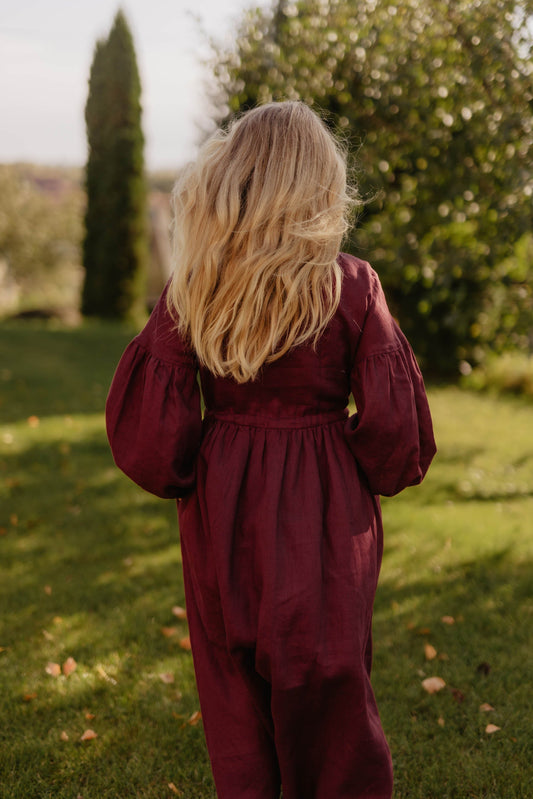
How to Tell the Difference Between Linen and Cotton: A Guide for Shoppers
Share
You see, linen and cotton are both awesome fabrics, but they have some differences that you should know before you buy them. In this article, I’ll show you how to tell them apart by sight, touch, or label, and why you should choose linen over cotton for your home textiles and clothing. Trust me, I know what I’m talking about. I work at Laumė family linen, a Lithuanian handmade linen clothes and home textile brand. We make beautiful and high-quality products from 100% natural, toxin-free, OEKO-TEX-certified linen. And we love it! Hope you will love it too.
So, let’s get started. Here are the main points I’ll cover in this article:
What is Linen and What is Cotton?
Linen and cotton are both natural fibers, but they come from different plants. Here are photos to show you the difference:
 |
 |
As you can see, linen comes from the flax plant, while cotton comes from the cotton plant. Flax is one of the oldest cultivated crops in human history, dating back to ancient Egypt and Mesopotamia. If you'd like to learn more about linen and how it's made, read our "What is Linen" article. Cotton is one of the most widely grown and used crops in the world, especially in tropical and subtropical regions.
But enough with the history lesson. Let’s talk about the properties of these fabrics.
Linen vs Cotton: Pros and Cons
Linen and cotton both have their pros and cons, depending on your preferences and purposes. Here’s a table that summarizes the main advantages and disadvantages of each fabric:
|
Fabric |
Pros |
Cons |
|
Linen |
|
|
|
Cotton |
|
|
So then you might be asking yourself. Why is linen so expensive?
Firstly, linen is more expensive than other fabrics because of the high cost and low supply of its raw material, flax. Flax is a crop that requires specific climatic and soil conditions to grow well, and it is mainly cultivated in Western Europe. Flax is also a crop that requires a lot of manual labor and time to harvest and process, as the linen fibers are hidden inside the stalks and need to be separated carefully. The weaving of linen fabric is also slower and more difficult than other fabrics, as the linen fibers are stiff and brittle and prone to breaking. All these factors contribute to the high price of linen fabric, which is reflected in the price of linen products.
However, linen is worth the investment because of its many benefits for your skin, health, and environment. Linen is a fabric that can last for decades if properly cared for, and it can improve your comfort and well-being in any season. Linen is also a fabric that has a unique and timeless appeal, and it can enhance your personal style and personality.
But don’t take my word for it. Try it yourself and feel the difference. Let me show you how to identify them by yourself.
How to Identify Linen vs Cotton
If you are shopping for linen or cotton products online or in person, you may want to know how to tell them apart by sight, touch, or label. Here are some tips on how to identify linen vs cotton:
By Sight
One of the easiest ways to tell linen from cotton is by looking at the weave of the fabric. Linen has a looser and more irregular weave than cotton. You may see some slubs or bumps in the linen fabric, which are natural variations in the flax fibers. Cotton has a tighter and more even weave than linen. You may not see any slubs or bumps in the cotton fabric, which are smoothed out during processing.
Here’s a close-up photo of a linen fabric:

And here’s a close-up photo of a cotton fabric:

Can you spot the difference?
Another way to tell linen from cotton is by looking at the color of the fabric. Linen tends to have a more muted and natural color than cotton. You may see some variations in the shade of the linen fabric, which are due to the natural dyes used. Cotton tends to have a more bright and vibrant color than linen. You may not see any variations in the shade of the cotton fabric, which are due to the synthetic dyes used.
Here’s a photo of some linen products in different colors:

And here’s a photo of some cotton products in different colors:

Which one do you prefer?
By Touch
Another way to tell linen from cotton is by feeling the weight of the fabric. Linen is heavier and stiffer than cotton. It may feel more substantial and structured in your hand. Cotton is lighter and softer than linen. It may feel more airy and flexible in your hand.
Here’s a photo of a linen shirt:

And here’s a cotton shirt:

Can you see how they hang differently?
Another way to tell linen from cotton is by feeling the texture of the fabric. Linen is rougher and coarser than cotton. It may feel more crisp and textured on your skin. Cotton is smoother and finer than linen. It may feel more silky and smooth on your skin. Quite visible on the photos above. And here's a fun anecdote from Lithuanian folklore about linen: it was thought that if linen on the wearer is soft and silky, he is a good person and if it was hard and rough the person was of bad intentions. What do you think your linen will feel like?
Linen is filled with rich history and folklore. Read our blog about the "Mystical powers of linen in Lithuanian and Scandinavian folklore".
By Label
The last way to tell linen from cotton is by reading the label of the product. Linen products should have a label that says 100% linen, flax, or linum. Cotton products should have a label that says 100% cotton, or a blend of cotton with other fibers. If the label does not specify the fiber content, you may want to ask the seller or manufacturer for more information.
Do you always check the labels before you buy?
Why You Should Choose Linen Over Cotton
Now that you know how to tell linen from cotton, let me tell you why you should choose linen over cotton for your clothing and home textiles. Here are some of the reasons why we believe linen is better than cotton:
- Linen is more durable and stronger than cotton. It can last for decades if properly cared for. Cotton may wear out or tear after repeated use or washing.
- Linen is more breathable and thermo-regulating than cotton. It can keep you cool in summer and warm in winter. Cotton may make you overheat or sweat more, especially in humid climates.
- Linen is more eco-friendly and sustainable than cotton. It requires less water, pesticides, and energy to grow and process than cotton. It is also biodegradable and recyclable. Cotton is one of the most water-intensive and polluting crops in the world.
- Linen has a unique texture and look that can enhance your style. It can create a cozy and elegant atmosphere in your home or wardrobe. Cotton has a plain texture and look.
Read about our sustainability efforts here.
But don’t just take my word for it. Take a look at some of the products we offer at Laumė family linen, and see for yourself how beautiful and high-quality they are.
Here are some of our best-selling linen home textiles:

- Linen Bedding Set for Toddlers: A cozy and breathable bedding set that can make your littles ones bed look like a dream. It includes a duvet cover, a flat sheet, and a pillowcases. It comes in various colors and sizes.
 |
 |
- Linen Table Runner: A elegant and rustic runner that can make your dining table look like a masterpiece. It has a simple design, a fringed edge, and a soft feel. It comes in various colors and sizes. At laumė we love our natural colors for every occasion, but for those special ones we'd recommend to try the deep blue linen.

- Linen Tea Towel: A soft and absorbent tea towel that can add to your kitchen a touch of flare. It has a a loop for hanging, and natural linen quick-drying feature. It comes in various colors and sizes. We'd placed the forest green at ours.
I hope you like what you see. If you do, please browse our site or Etsy page to browse more of our products. We also offer custom orders, gift wrapping, free shipping, and friendly customer service.
Conclusion
Linen and cotton are both great fabrics for clothing and home textiles, but they have different characteristics, advantages, and disadvantages. By knowing how to tell them apart by sight, touch, or label, you can make informed and smart choices for your shopping.
But if you ask me, I would always choose linen over cotton for my clothing and home textiles. Linen is more durable, breathable, eco-friendly, and stylish than cotton. And at Laumė family linen, we make sure that our linen products are made with love and care from 100% natural, toxin-free, OEKO-TEX-certified linen.
So what are you waiting for? Go ahead and treat yourself to some linen products from Laumė family linen today. You won’t regret it!
I hope this article helps you understand how to tell the difference between linen and cotton. If you have any questions or feedback contact us at contact@laumelinen.com



